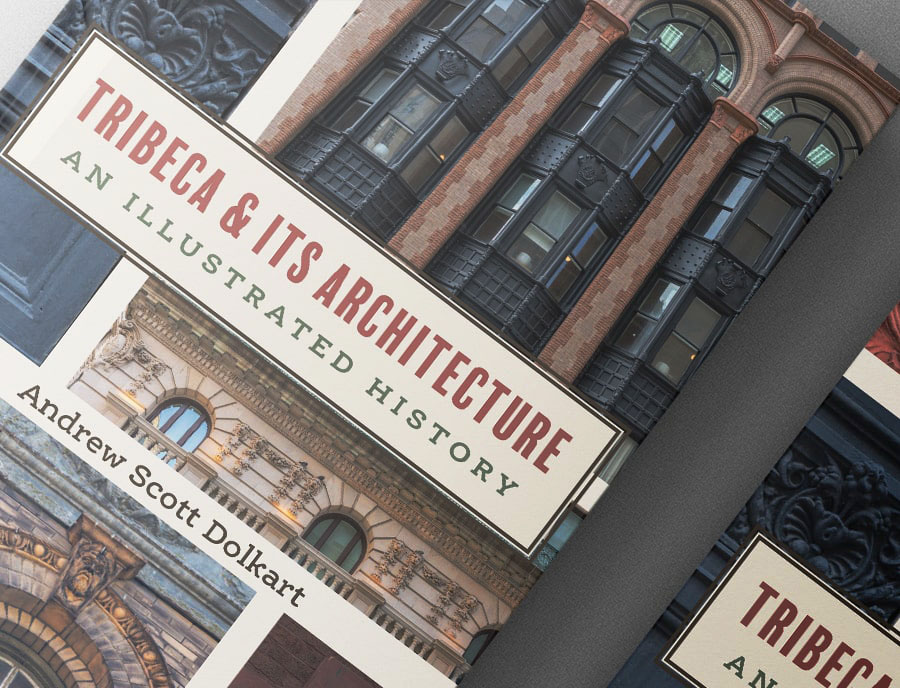In this issue:
- The Human-Scale Vision: Op-Ed
- The Backlog
- Clergy Rips Mayor’s Housing Plan
- Lawsuit filed against Brooklyn’s Community Board
- Another reason why we must reform Air Rights Transfers
- Surprise, surprise: Mayor’s Office Bullies Community Board 8 in Brooklyn
- Alicia Glen admits to her concern for “developer’s bottom lines”
- East Fifties Alliance Gets Lucky
- Darth Vader Tower by SHoP Proposed for Brooklyn
- Stringer Finds Empty Lots All Over New York: Zero Community Planning
- SHoP Architects Homogenizes Manufacturing District – and the rest of the city: sign the petition
- Petition (sign it!) to Save an Old Bank Building from being Turned into a 14 story luxury condo
- Thanks to the Interns!
The Human-Scale Idea
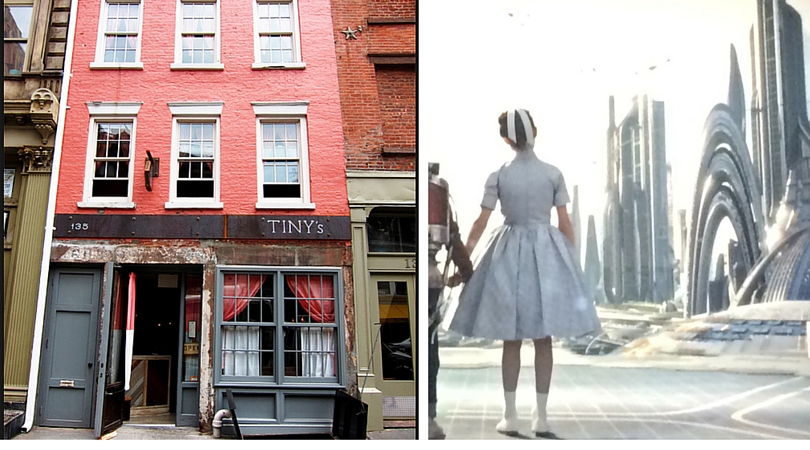
The Human-Scale City versus Disney’s “Tomorrowland”
Faced with the debacle that is the ZQA upzoning and the recent Common Cause revelations of the Mayor’s ties to real estate, proponents of New York’s great “urbanity” and distinctive character might easily feel discouraged at the present moment. Sure, there is the cold “told-you-so” comfort we might take in knowing this: in the long run of history, the Bloomberg and De Blasio administrations will go down as the worst destroyers of the great urbanity that was once New York City, along with all the City Council members and appointed commissioners who went along with them.
But that is cold comfort indeed, for it comes with the grief at the scale of destruction our city is undergoing. The Bloomberg/De Blasio vision of our future is terrible to behold. It is a vision of Dubai-on-Hudson – a bristling, look-alike world of mega-towers. And this vision is spreading like a disease to every neighborhood. The distinctiveness of New York is being lost in a sea of glass. Our city is beginning to look like all the other bland, nowhere places, the cities without histories, a city where we are but serfs to the Lords of Real Estate and the desire of the city to supply itself with real estate taxes.
The politicians and developers and their architects pretend that the hostile, windswept corporatist plazas that our city is being reduced to are somehow okay. They glibly assure us that a bit of afterthought landscaping and “placemaking” in those plazas will redeem the soulless blocks they have created. What fools they must think we are.
And it seems this week that their vision has the upper hand. And maybe it does – for the moment.
But just for the moment. At every point in history, there was always an alternative idea about how things could be. Such alternative ideas don’t disappear into some obscure Zeitgeist. They live on. It took 56 years to ban child labor. It took many generations for women to get the vote.
But we don’t have a lot of time. To regain the the upper hand we have a big job ahead. The first task for us is to translate a human-scale vision into concrete policy reforms, rule changes and new legislation. The second task is to find a way to elect people who will agree to and fight for those policies and rule changes. All of this will require a certain ferocity about restoring a more genuine, less corrupt democracy, one less beholden to Big Real Estate. That job falls to us all.
But remember, no change of any importance happened without people saying it should be so. So read on, and you will find people who are bravely doing their part in what see seems to be a kind of war against the Goliath that is the real estate industry of our city. There are bad guys and goods guys. It is an amazing story and we are living it.
Correction: an earlier version of this post erroneously introduced this letter with reference to the wrong critic and incorrect editorializing. That has been corrected. Apologies to all for the error.
The Backlog
The ever-insightful Christobel Gough of the Society for the Architecture of the City sent us another letter, which I am honored to reproduce here.
Here is her letter:
Back Before the Backlog: Quandaries of Landmark Designation
Many journalists—and many preservation advocates—took notice of the Landmarks Preservation Commission’s (LPC) most recent meeting of February 23. Many did not like what they saw. There was a general assumption that the very existence of a backlog of “heard but not designated” properties was an embarrassment. Thus reporting on the backlog hearing , we heard from the New York Times that those undesignated items had “languished in limbo for decades.” That language that was then echoed by the Associated Press, and so repeated all over the United States.
Public complaints addressed not only past failures to act, but present decisions to refuse to postpone action any longer. The Wall Street Journal headline on the matter was thus “NYC Commission denies landmark label to 65 properties: potential designation to move forward for 30 other sites that were in bureaucratic limbo.” With such a “heads-I-win-tails-you lose” perspective, the LPC could scarcely redeem itself whatever it did.
However, such criticism tends to ignore history. In 1970, “landmarks limbo” began with a brilliant evasive action by Harmon Goldstone, the second LPC Chairman, when he made a very conscious and very wise administrative decision that may have prevented the newly enacted landmarks law from being overturned by the courts.
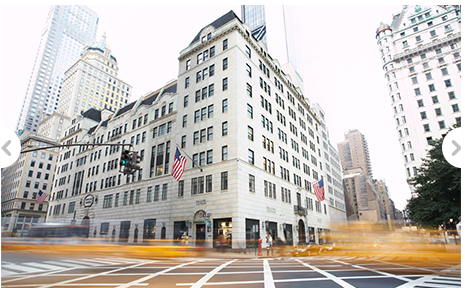
The first years of the commission were a time of fear and pressure. Commissioners and staff were charged with the preservation of everything of architectural or historic value in this huge city, with the most minimal resources, in the face of a huge boom in real estate investment and construction. Which were the best of the best, the buildings that if lost would be the undoing of the city?
In 1965, they calendared and heard 29 individual landmarks and the Brooklyn Heights Historic District, and by 1970 there were several thousand protected structures by virtue of the designation of Greenwich Village and Cobble Hill Historic Districts. Hanging over them was the window of opportunity for demolition written into the first version of the law at the request of the real estate industry: a periodic moratorium on designation.
Some of their choices were visionary and so far ahead of conventional views of what the city should be that five decades later we are barely catching up with their perceptions. Unsentimental about the demolition of the Vanderbilt Mansion at 5th Avenue and 58th Street, they looked to the framing of the plaza it faced, with St. Gaudens’ great gilded equestrian statue of Victory leading the Union, Olmsted’s Central Park to the west, Hardenbergh’s Plaza Hotel, Stanford White’s Metropolitan Club. This was Manhattan’s great historic public piazza, our answer to Trafalgar Square or Place Vendome. The commission moved to protect the building that was successor to Vanderbilt’s palace, even though it was barely old enough to designate, even though it was created by a man who was new in architectural circles then, not one of the established builders of colonial revival estates and clubhouses, but a designer of big commercial buildings graced by jazz age Parisian terra cotta friezes and terraced outlines, Ely Jacques Kahn. Long before contextual became a buzzword, Kahn dropped his usual style to design a Bergdorf Goodman’s that fit the site and furthered the unity of buildings embracing the classic open space. His concept reflected both the landmarks we still see there today and a now lost row of tall marble townhouses that the divisions of his design echoed, as well as a subtle evocation of the lost Vanderbilt mansion on Bergdorf’s north façade.
When Harmon Goldstone brought Bergdorf Goodman’s forward for designation in 1970, all hell broke loose. Mr. Goodman was not having it. He arrived at the designation hearing with a retinue of lawyers and consultants who made it clear that immediate litigation was the next step. Testimony was even drafted in the form of a memorandum of law and multiple affidavits. This we know because the LPC Research Department published on line their building files for every item on the backlog.
Imagine if the first test of the constitutionality of the new landmarks law had been centered on an elite department store, exclusive and expensive, quite recently built, an agent of neighborhood change that brought commercial use to the formerly residential site of a recently demolished great mansion, a tactful and even self-effacing replacement, created by an architect then barely known to the man in the street. Not a potentially populist cause for a law that was to forestall “irreplaceable loss to the people of the city” of their historic heritage. LP-0001, the first designation, had been a 17th century Dutch farmhouse.
Harmon Goldstone punted. He delayed designation. Bergdorf Goodman became the first initiative to land in what we now call the “landmarks limbo.” But in 1972 Goldstone decided that the time had come to accept the challenge of litigation. The proposed destruction of Grand Central Terminal became the test case that eventually validated the landmarks law. That pivotal 1978 Supreme Court decision, Penn Central Transportation Co. v. City of New York, found that governmental designation and regulation of a landmark does not constitute a taking of property under the Fifth and Fourteenth Amendments. Without that decision, no local landmarks law could have survived for long, and America would be a very different place.
The shock of a corporate applicant coming to build a fifty-story investment skyscraper right on top of Grand Central Terminal, dwarfing the majestic building and gutting the great concourse that millions of people knew and loved, that was the right moment for a fight that everyone immediately saw as important and necessary.
So delay is not necessarily slothful or inefficient. It can be strategic. An action of the Landmarks Commission may require validation by the City Council and the Mayor, and must always have a rational basis that can survive litigation. Now, in 2016, it may be feasible to go forward with the designation of Bergdorf Goodman’s, as New York begins to recognize the importance of urban design to its future as a great city, and the beauty of a contextual architecture that can further urban design goals. Other outstanding commercial buildings by Ely Jacques Kahn are landmarks now, 2 Park Avenue, and the Holland Plaza Building. A more complete picture of his work is beginning to emerge, including even work lost to fire, his renovation of an interior that could not be landmarked because it is an “interior utilized for religious worship,” Central Synagogue. New York moves forward in different ways, and landmarking moves forward with it.
![]()
Daily News: “Clergy Rips Mayor’s Housing Plan”
“We are calling for a better plan or no plan at all” say 79 members of the clergy, six of whom are on the Mayor’s Clergy Advisory Council.
Does the Mayor care? Nope. He shrugged it all off saying that people will all “have their viewpoints”. Read the article here.
The Mayor also doesn’t care that 86 civic and community organizations around the city have been pleading for him to change course.
He doesn’t care that community boards voted overwhelmingly against the ZQA/MIH plan.
He just doesn’t care.
![]()
Lawsuit Charging Corruption Filed Against Brooklyn Community Board 9


Alicia Boyd’s wrongful arrest at a community board meeting – (all charges dismissed)
This week Crown Heights residents Alicia Boyd, Janine Nichols and Pamela Yard, with the financial and logistical support of neighbors, many of whom submitted affidavits, filed a 167-page lawsuit in Kings County Civil Court against Brooklyn Community Board 9. Two hundred pages of evidence accompany the filing (Index #1835/2016). In a historic first, the suit seeks the removal of board members, namely, Demetrius Lawrence (Chair), Michael Liburd (Chair, ULURP), Tim Thomas, Warren Berke (Chair, Economic Development) and also names Terry Witherspoon, Community Assistant at CB9, who has been managing the district office since the dismissal of District Manager Pearl Miles last year. She is the Board’s only current employee.
CB9 has become infamous among the city’s community boards for its deep divisions, uproarious protests, and arrests. In this case depicted above, all charges against protestors were later dismissed. Petitioners allege that CB9 displays continuing and contemptuous disregard for all laws governing the actions of community boards, namely, the City Charter, Open Meetings Law and CB9’s own Bylaws, violations detailed at length in the filing.
The suit challenges the legality of the so-called “Second Letter” from CB9 to the Department of City Planning. The letter requests a re-zoning that Petitioners believe will result in the displacement of Black residents from the Prospect Park-facing neighborhood. The text of that letter has still never been released to the community, and was “passed” by the Board in May 2015 without public discussion.
For further information, contact Alicia Boyd: aliciaboyd@earthlink.net (718) 703-308.
For other views on these contentious matters, look around the local blog “The Q at Parkside” here.
![]()
Another Reason Why We Need to Reform Air Rights Transfers
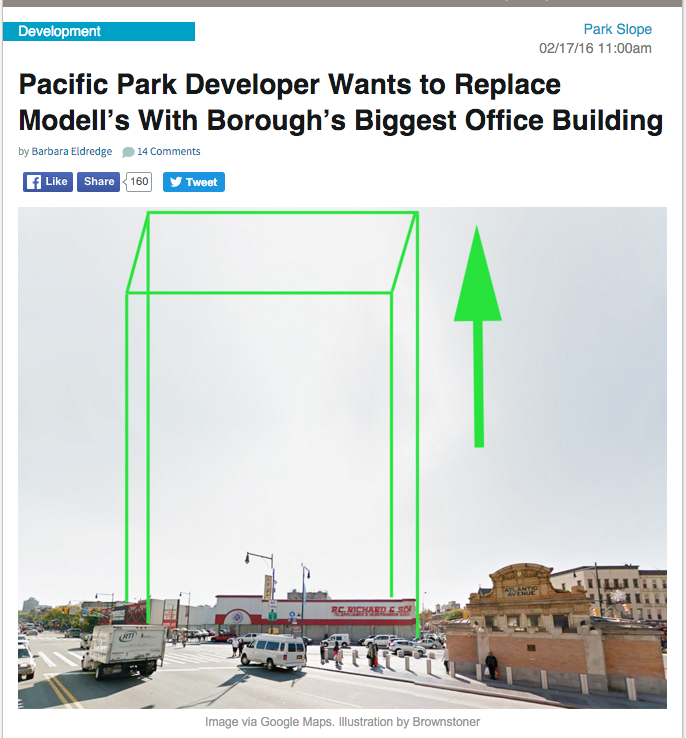
Brownstoner and St. Mark’s Block Association report that the Empire State Development Association (ESDC) is in the process of approving / facilitating an office tower with a 1.5 MILLION square ft. footprint and an undetermined height that would replace the Modell’s and PC Richards box stores on that small triangular patch off Flatbush at Atlantic. They would be using an air rights transfer to do so.
This construction would be IN ADDITION to the 17 towers that are approved and will eventually be built on the Atlantic Yards/Pacific Park site that is two blocks away from us. The images here are from the Brownstoner article and they gives a sense of the “proposed” new building, which is being treated like an update to the original project plan: http://www.brownstoner.com/blog/2016/02/atlantic-yards-office-building-brooklyn-forest-city-590-atlantic/
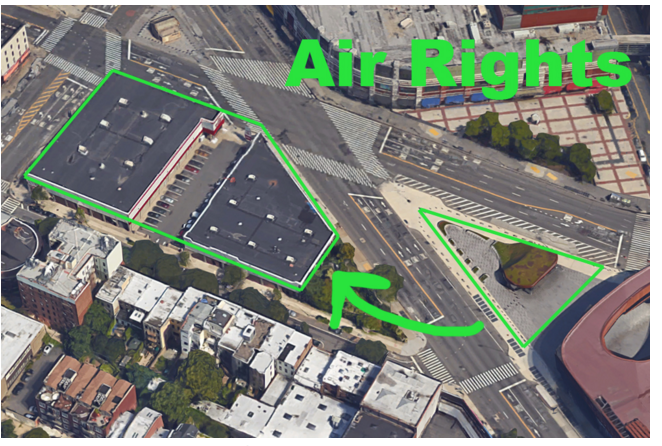
“Sadly,” says one observer, “there will be little or nothing that we can do about this new development. There will be some farcical ‘public hearings’ but the neighborhood has no leverage with Greenland Forest City, which is in essence a Chinese company (the Greenland Group, essentially owned by the Chinese government, owns 70% of this project, which our tax dollars support) and the ESDC has more than demonstrated its willingness to bend over for whatever developers want. Our elected will do nothing about this, and Mayor De Blasio supports it.”
![]()
Mayor’s Office Bullies Brooklyn’s CB8
Bullying up-zoning politics revealed! Backstory is simple: Brooklyn’s Community Board 8 – who had voted a solid no on the ZQA upzoning – also wants to change land use rules in the Crown Heights manufacturing district, to support manufacturing. To that end, they requested support from the Mayor’s office for a survey of manufacturing assets in their neighborhood. The Mayor’s office responded thus: “Such a study would be a major commitment by this agency and could only be undertaken if there was a willingness and commitment by the community board to advocate and support necessary zoning changes [for the ZQA upzoning].”
Gib Veconi, a co-chair of the M1-1 Zone Subcommittee in Brooklyn and of the group Brooklyn Speaks, responded: “This is a city agency saying that we can only cooperate with you if you support the program that we’re promoting. There’s just no way for a community board to do that over the objections of residents of the district.”
Another translation for the Mayor’s bullying: Drop Dead, Brooklyn.
To read the full article, click here.
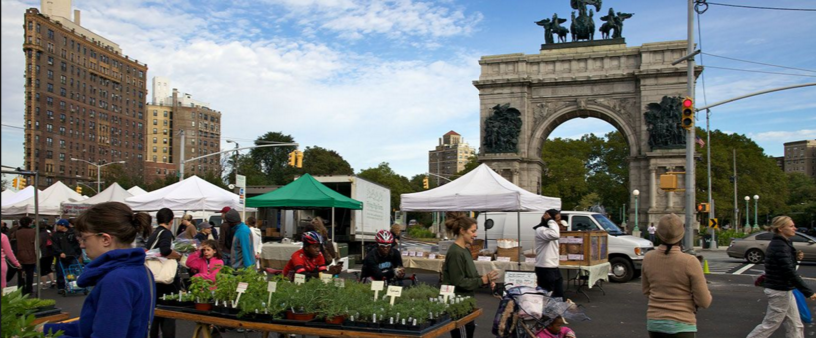
![]()
Noodling Around the Edges of a Bad Policy
-Glen’s true anxiety is “preserving developer’s bottom lines”
Crain’s Business this week highlighted a possible compromise to the upzoning/housing-plan proposed by the City. Deputy Mayor, Alicia Glen stated that, “To the extent that there is some consistent feedback that we need to look at different [income] tiers, even within the tiers, I think that we’re open to those discussions.” Sounds like its talk of a new tier with a lower average rent. “Such a change would mean, for instance, instead of $1,166 rents for a family of three, developers would need to hit $777 a month. To preserve developers’ bottom lines, this tier would likely need to have fewer affordable apartments than the other tiers.“
To read the full article at Crain’s, click here.

![]()
The East Fifties Alliance may be getting lucky: Foreclosure Auction for Controversial Mega-Tower
According to Crain’s, the Bauhaus Group (developers of the insane megatower at 428-432 East 58th Street) are having trouble paying back their loans and their lender is putting the property to a foreclosure auction. Will that spell doom for this terrible project? Let’s hope so.
To read the full article, click here.
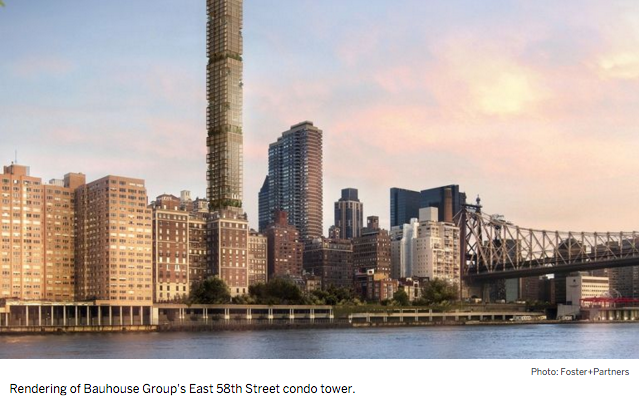
![]()
Darth Vader Super-Tower for Brooklyn Planned on Landmarked Bank Site
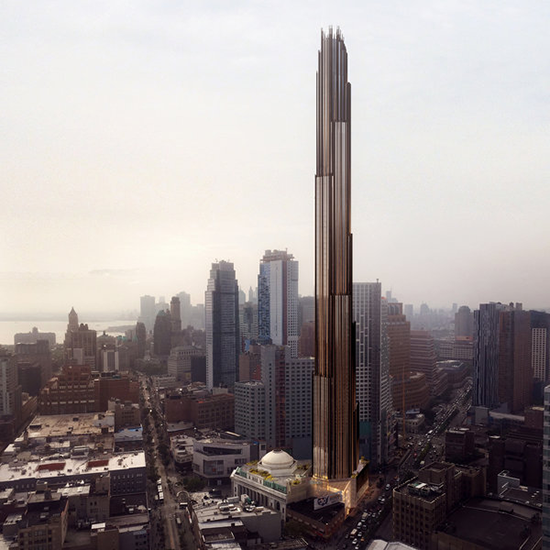

The new tower was proposed by JDS Development Group and the Chetrit Group. Photo from New York Times. Horrible design by SHoP Architects, who seem to have their paws in every project in the city.
Hard to believe, I know, but a new super-tower was approved by the Brooklyn Community Board 2 land-use committee for downtown Brooklyn. Exactly how do community boards justify that kind of vote? The 1,066- foot tower will be built along Flatbush Avenue and reside next to two City landmarks, the Brooklyn Dime Savings Bank, which is protected by landmark status, and Junior’s Cheesecake restaurant, an unofficial landmark. The building would be the borough’s first super-tower and would destroy part of the bank to help support its gigantic frame.
Council members foolishly see this new development as one of the only ways they could have saved the Bank structure and in the Orwellian world they live in, praised developers for creating a building that would “complement the area.” An amazing statement, for a building that will do more to destroy the character of Brooklyn than any other building so far. Except of course for the proposed Long Island Hospital building…
Time for a new council member over there?
Planned as a rental apartment building, the Brooklyn development would be different from the buildings going up in Manhattan, which are mainly condos. This may be a response to the projected fall in demand for expensive condos as the market for these dries up. The building applied for a 421-a tax abatement before it expired in January, which would require at least 20% of the rentals to be designated as affordable housing. There have been predictions that the tower would be difficult to fill by the time it is built, as the market becomes more saturated with luxury rentals.
To read the article, click here.
![]()
Mayor’s Inaction on Empty Lots Brings Criticism from Scott Stringer


Lots like these sit unused, with potential for affordable housing or community projects. Photo from Gotham Gazette.
Comptroller Scott Stringer released a report on over 1,000 unused city-owned empty lots. The Housing Department has been busy coming up with excuses for why most of these lots have not been developed or turned into parks.
For the lots that have been selected for development, the Department of Housing Preservation has supposedly “been in talks with the community” over how to best use the space. However, there is little evidence within the communities of any such community engagement process. That is because, guess why…. we have no legitimate community planning process in this city.
Many of these lots have been vacant for 30 or 40 years with no word from the City on plans to develop them. On a positive note, due to the Comptrollers report, those responsible for the empty sites may be held accountable in the next two years.
To read the article, click here.
![]()
SHoP Architects Pushes the Homogenization of Brooklyn at Paragon Paint Building
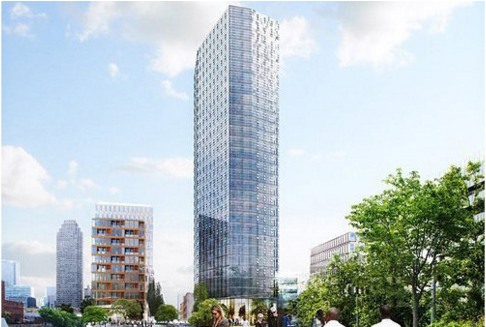

Ever notice how everything SHoP Architects designs looks exactly the same as everything in Houston or a Shanghai suburb?
Unlike Community Board 8, which supported the ridiculous tower for Queens (see article above), Jenny Dubnau reports to us from Community Board 2 on the latest in the Paragon Paint factory redevelopment: “So the Community Board voted overwhelmingly against the luxury towers on this site. It now goes to the Board of Standards and Appeals (this is a new one on me: if there is a special circumstance, such as toxic waste remediation—which there was in this case—the developer can bypass the normal city council zoning variance process and go before the BSA. It’s a city agency; I worry that it’s similar to the EDC, and that it will be a rubber stamp. Apparently Jimmy Van Bramer authored a bill to eliminate the BSA process, calling it undemocratic. The bill is sitting in committee. De Blasio has apparently said such a bill would be “illegal.”).
Jenny also says: “A few of us locals started a petition to the BSA, which we’d be honored if you’d share: http://tinyurl.com/hnrbavu“
Happy to do so. It is an eloquent petition too. You do not have to be a Queens resident to sign. Please sign it!
![]()
Greenpoint Savings Bank Building to be demolished in Brooklyn for Luxury Condo
You can sign the petition against this demolition here.
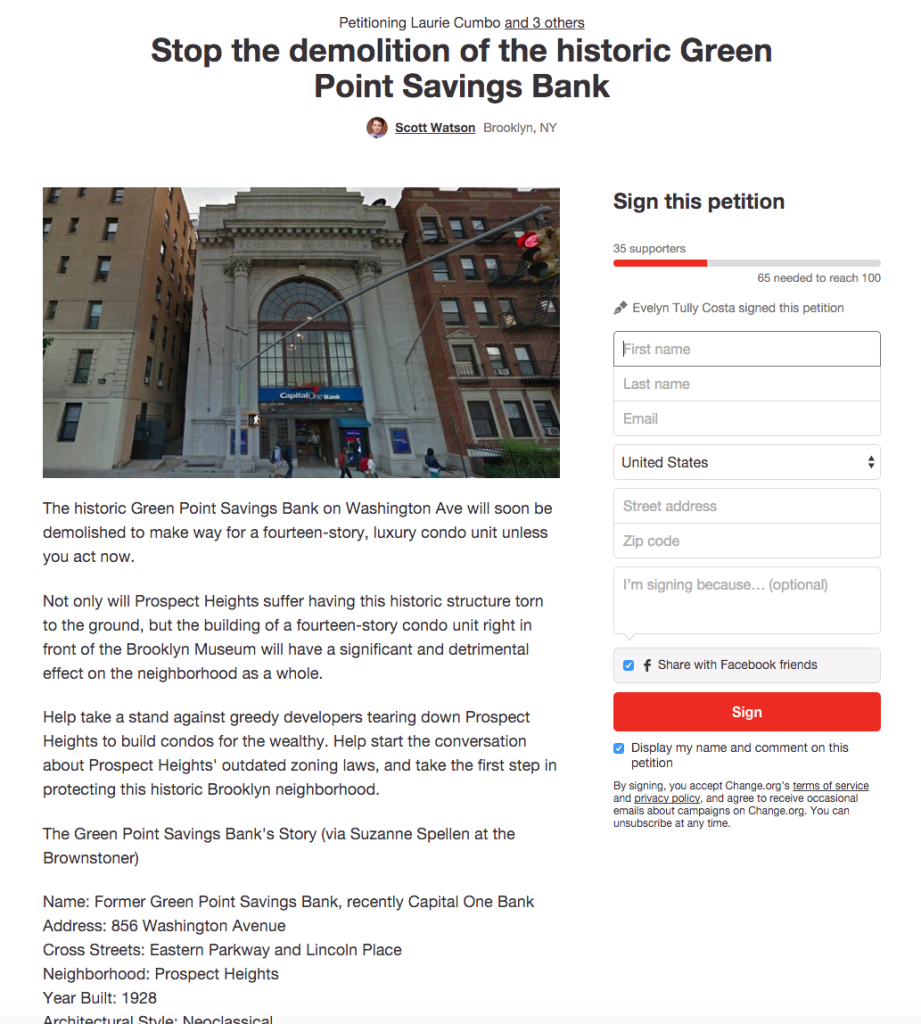
![]()
Thanks to our interns for working on these roundups! They do a great job in an incredibly tight timeframe and they would not be happening at all were it not for them.


Louise Carhart, Grinnell College student, interns with New Yorkers for a Human-Scale City. She is an East 50’s resident


Darcy Riley, preservation student at Rutgers interns with Tribeca Trust intern. She is depicted here at field school in Turkey.

